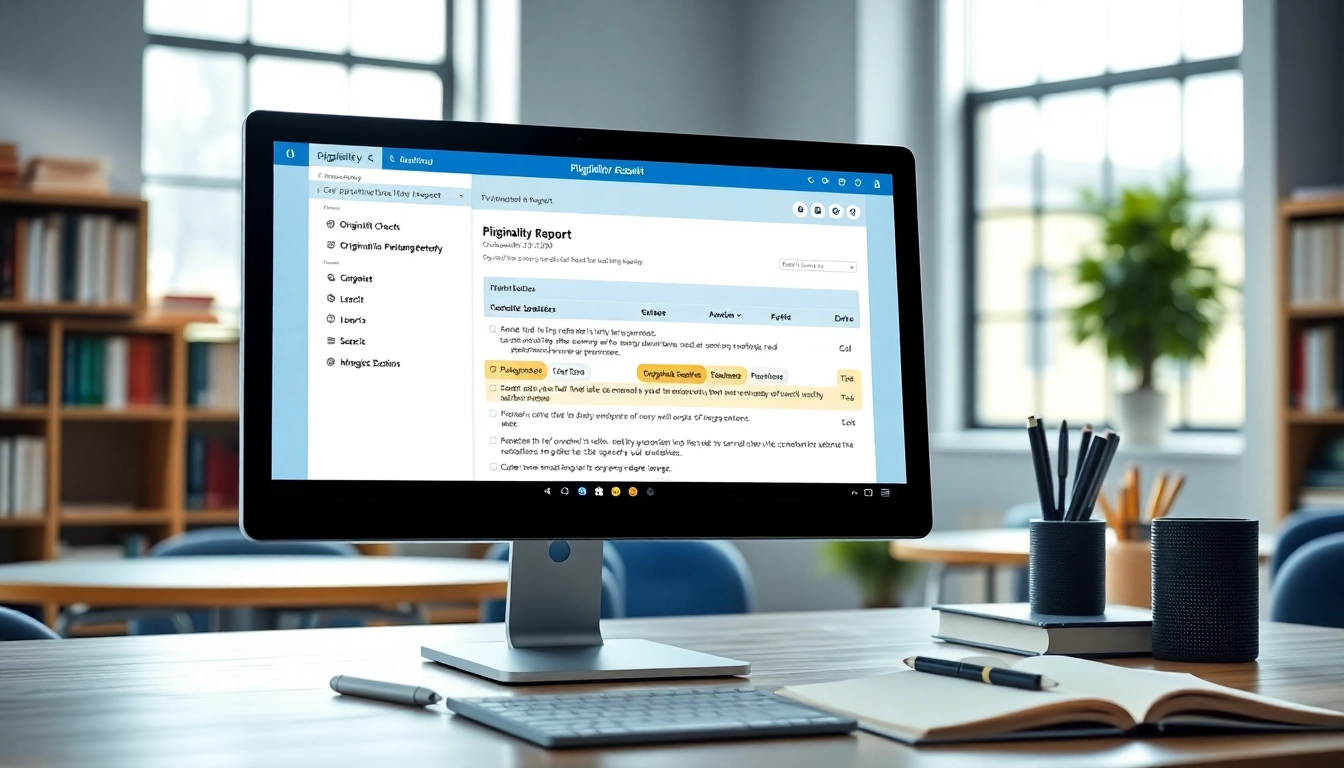Understanding Plagiarism and Its Consequences
What is Plagiarism?
Plagiarism is the act of using someone else’s work, ideas, or intellectual property without proper citation, presenting it as your own. This unethical practice can occur in various forms, including copying text from books, articles, websites, or even individual phrases. It’s crucial to understand that plagiarism is not limited to academic settings; it can affect creative industries, academic research, and corporate environments as well. While the implications of plagiarism can be dire, leading to damaged reputations, legal troubles, or academic penalties, the importance of upholding integrity in all forms of writing cannot be overlooked.
Types of Plagiarism
Understanding the different types of plagiarism is vital for anyone engaged in writing, research, or creative endeavors. The primary types of plagiarism include:
- Direct Plagiarism: Copying someone else’s work word for word without acknowledgment.
- Self-Plagiarism: Reusing your previous work and presenting it as new without citation.
- Accidental Plagiarism: Unintentionally failing to cite sources or misquoting someone.
- Paraphrasing Plagiarism: Rephrasing someone else’s ideas without appropriate citation.
- Patchwriting: Copying phrases from a source while changing some words or structure.
The Importance of Academic Integrity
Academic integrity serves as a cornerstone of higher education and scholarship. It emphasizes honesty, transparency, and respect for the work of others. Violations of academic integrity, such as plagiarism, can not only jeopardize an individual’s academic record but can also diminish the value of their work and that of their peers. Institutions are increasingly adopting strict policies and automated systems to detect plagiarism, highlighting the critical nature of adherence to ethical standards in academia.
How a Plagiarism Checker Works
Algorithm and Database Behind Plagiarism Checkers
A plagiarism checker operates by comparing a given text against a vast database of sources using sophisticated algorithms. This database includes published articles, research papers, and web pages. The checker identifies similarities and matches between the submitted content and existing sources. The algorithms analyze various linguistic aspects, such as word structure, order, and contextual meaning, which helps in pinpointing even subtle plagiaristic practices.
Real-time vs. Post Submission Checks
Plagiarism detection tools can typically be categorized into two types based on when they assess the text:
- Real-time Checks: Best for writers and students who want to ensure originality during the writing process. These tools provide immediate feedback to identify areas that may require rephrasing or citation.
- Post Submission Checks: Often used by educators and corporations, these tools analyze submitted work after completion to evaluate its originality and adherence to academic standards.
Reporting and Analysis Features
Effective plagiarism checkers provide detailed reports that highlight potential plagiarism occurrences. These reports include:
- The percentage of similarity detected.
- Specific sections of text that are flagged as plagiarized.
- Links to the sources of similar content, allowing the user to verify and assess the relevance.
By offering such comprehensive analysis, plagiarism checkers empower users to rectify issues before submitting their work, helping to uphold academic standards.
Choosing the Right Plagiarism Checker
Key Features to Look For
With numerous plagiarism checking tools available, it’s essential to select one that meets your specific needs. Here are key features to consider:
- Database Size: A larger database ensures a more comprehensive comparison, increasing the likelihood of detecting plagiarism.
- Speed and Efficiency: Quick scanning capabilities help save time, especially for students and professionals on deadlines.
- Intuitive User Interface: A user-friendly design simplifies the process, making it accessible for users with varying tech skills.
- Feedback Utility: Tools that provide actionable feedback, such as suggestions for rephrasing and citation, enhance the writing process.
Comparing Popular Plagiarism Checkers
Some of the leading plagiarism checkers include:
- Grammarly: Offers a robust plagiarism detection feature along with grammar and style suggestions. Its large database compares text against millions of publications.
- PapersOwl: A free online tool that delivers accurate reports using AI technology. It supports various file formats, making it versatile.
- Duplichecker: A free service that is easy to use, allowing users to check for plagiarism quickly with simple copy-paste functionality.
- Scribbr: Known for its academic focus, Scribbr is utilized by universities and offers in-depth reports that highlight sections requiring citation.
Free vs. Paid Services: Which is Worth It?
The debate over free and paid plagiarism checkers often depends on the user’s needs. Free services provide basic functionality sufficient for casual users or students. However, paid services usually offer advanced features such as:
- Access to extensive databases including scholarly articles, journal entries, and proprietary publications.
- Detailed and comprehensive reports with feedback tailored to improving writing quality.
- Advanced algorithms capable of detecting various forms of plagiarism that free versions may miss.
Ultimately, the choice hinges on the volume and nature of writing produced, as well as institutional requirements.
Best Practices for Avoiding Plagiarism
Effective Research and Note-Taking Strategies
A strong foundation in research and note-taking can significantly mitigate the risk of plagiarism. Consider implementing the following strategies:
- Use a research management tool, such as Zotero or Mendeley, to organize sources and make citations easier.
- Take thorough notes while documenting the source of each idea or quote. This will provide clarity during the writing process.
- Summarize information in your own words to ensure comprehension and reduce reliance on direct quotes.
Proper Citations and Referencing Techniques
Understanding and utilizing proper citation styles (APA, MLA, Chicago) is essential to maintaining academic integrity. Follow these guidelines:
- Familiarize yourself with the specific requirements of your field regarding citations and references.
- Consistently apply citation styles to ensure that you give appropriate credit for ideas, methods, and data.
- Utilize citation manager tools to simplify the tracking and formatting of references.
Utilizing Paraphrasing Tools Alongside a Plagiarism Checker
Paraphrasing tools can assist in rewording content while retaining the original meaning, which is an excellent strategy when you need to cite someone else’s work. However, it’s crucial to pair these tools with a plagiarism checker to ensure that your rephrased content does not inadvertently resemble the source material too closely. This hybrid approach not only guards against accidental plagiarism but also enhances writing fluency and creativity.
Improving Writing Skills with a Plagiarism Checker
Feedback and Improvement via Plagiarism Reports
Using plagiarism checkers can have a dual benefit: ensuring originality and providing critical feedback on writing. The comprehensive reports offered by advanced plagiarism tools highlight specific phrases or sentences that may need revisions or citations. This feedback can serve as a learning tool to improve writing techniques and develop a more authentic voice.
Using AI to Enhance Originality in Writing
AI-powered plagiarism checkers continuously improve their algorithms to better understand language patterns and context. These advancements allow for more nuanced detection of plagiarism and greater support in crafting original content. Writers can leverage these tools to experiment with style while ensuring that they maintain originality and academic integrity.
Case Studies: Successful Plagiarism Management
To exemplify the effectiveness of plagiarism checkers, consider the case of a graduate student who relied heavily on various online sources for their thesis. Initially unaware of the nuances of citation and proper paraphrasing, they encountered multiple instances of plagiarism. Upon utilizing a plagiarism checker, they received immediate feedback, allowing them to correct their citations and paraphrase effectively. This proactive approach not only salvaged their academic standing but also significantly enhanced their understanding of scholarly writing conventions.
In conclusion, plagiarism is a serious issue in today’s knowledge-driven society, and ensuring the originality of one’s work is critical. By understanding its nuances and leveraging advanced plagiarism detection tools, writers can not only protect their integrity but also improve their overall writing skills. These measures, combined with effective research strategies and proper citation, create a robust framework for academic and professional success.



